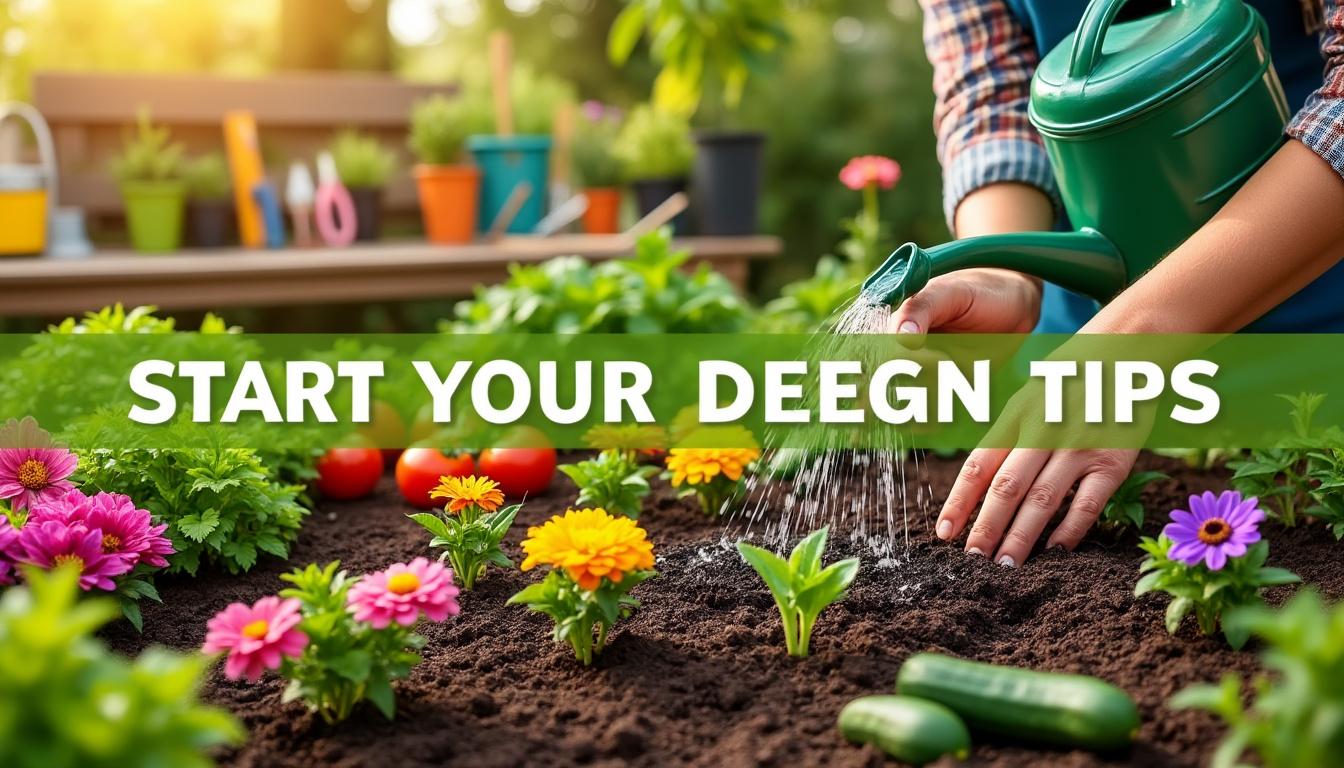Launching a successful gardening journey requires more than just planting seeds—it demands strategic planning, knowledge of local conditions, and the right tools. As urban landscapes evolve in 2025, gardeners face fresh challenges and opportunities alike, from space constraints to the latest advances in gardening technology. Unlocking the potential of your green space begins with understanding sun exposure, soil quality, and plant compatibility tailored to your environment. This foundational knowledge empowers beginners to cultivate flourishing gardens that nourish both body and mind.
Key Strategies for Selecting the Ideal Garden Location to Maximize Growth
The foundation of any thriving garden is its location. Selecting a site with optimal sunlight profoundly influences plant health and yield. Most vegetables demand no less than six hours of direct sunlight, with sun-loving crops such as tomatoes and peppers needing the full sun spectrum. Shade-tolerant plants like lettuce or spinach expand options for partially sunny spots. Additionally, proximity to your residence significantly improves garden upkeep, facilitating consistent watering and timely harvests. An informed choice in location streamlines maintenance and optimizes productivity.
- Ensure at least 6 hours of direct sunlight daily.
- Select locations near the home for ease of access.
- Match plant varieties to available sunlight to avoid growth issues.
- Assess soil drainage and composition at potential sites.
- Consider security and protection from local wildlife.
| Plant Type | Sunlight Requirement | Ideal Location |
|---|---|---|
| Tomatoes, Peppers | Full Sun (6+ hours) | South-facing garden beds |
| Lettuce, Spinach | Partial Shade (4-6 hours) | East or West-side beds |
| Herbs (e.g., Basil) | Full to Partial Sun | Windowsills or containers |
Mastering Efficient Watering: Accessible Irrigation and Tools
Ensuring your plants receive sufficient water without exhausting the gardener is paramount. Implementing reliable irrigation systems like drip irrigation can significantly reduce labor and conserve water, vital during heat waves when gardens demand consistent hydration. Brands like Gardena and Miracle-Gro offer state-of-the-art watering solutions, simplifying this task. For beginners, investing in these technologies fosters plant health and frees time for other gardening activities.
- Install drip irrigation systems for targeted watering.
- Keep hoses with sprayer attachments handy for flexibility.
- Water early in the morning or late afternoon to reduce evaporation.
- Regularly check for leaks or blockages in irrigation setups.
- Use moisture sensors to optimize watering schedules.
| Watering Method | Advantages | Recommended Brands |
|---|---|---|
| Drip Irrigation | Efficient water use, less weed growth | Gardena, Scotts |
| Sprayer Hose | Flexible, easy to control water flow | Fiskars, Miracle-Gro |
| Soaker Hose | Slow, deep watering for roots | Gardeners Supply Company |
Enhancing Soil Quality with Organic Matter for Robust Garden Growth
Soil composition stands as the cornerstone for garden success. Healthy plants rely on well-drained, nutrient-rich soil that nurtures roots and sustains moisture. Incorporating organic amendments such as compost, leaf mold, or well-aged manure—never fresh manure due to pathogen risks—greatly enhances soil structure and fertility. Trusted products like Espoma’s organic amendments provide consistent quality. Experts including Monty Don emphasize the transformative effect of organic matter in creating thriving garden ecosystems.
- Use compost or leaf mold to boost nutrient content.
- Apply well-aged manure carefully for natural fertilization.
- Avoid compacted or waterlogged soils to prevent root damage.
- Test soil periodically for pH and nutrient levels.
- Consider raised beds with fresh soil mix for poor native soils.
| Soil Amendment | Benefits | Application Tips |
|---|---|---|
| Compost | Improves fertility and drainage | Mix into top 6-8 inches of soil |
| Leaf Mold | Enhances moisture retention | Spread as mulch or mix into soil |
| Aged Manure | Adds essential nutrients | Composted for 6-12 months before use |
Choosing Seeds Versus Plants: Tailoring Your Garden for Optimal Results
Determining whether to sow seeds directly or transplant seedlings affects starting your gardening journey efficiently. Fast-growing vegetables such as beans, carrots, and lettuce typically thrive when sown directly outdoors. In contrast, more demanding crops like tomatoes or eggplants benefit from an indoor head start or purchasing quality transplants from nurseries such as Burpee or Proven Winners. Aligning these choices with seasonal planting calendars ensures maturity within your local growing period.
- Sow quick-maturing crops directly to the soil.
- Start tomatoes and peppers indoors 6-8 weeks before outdoor planting.
- Select plant varieties suited to your region’s frost dates.
- Utilize tools by Fiskars for transplanting to minimize root disturbance.
- Refer to planting calendars to schedule sowing and harvest times.
| Crop | Planting Method | Ideal Timing |
|---|---|---|
| Beans, Carrots, Lettuce | Direct Seed | After last frost |
| Tomatoes, Peppers, Eggplants | Transplants or Indoor Start | 6-8 weeks before last frost |
| Squash, Cucumbers | Direct Seed or Transplant | When soil warms up |
Utilizing Space Efficiently: Raised Beds and Containers for Urban Gardeners
Space constraints and soil limitations can be overcome by adopting raised garden beds or containers. These approaches allow control over soil quality, drainage, and plant placement, making gardening accessible in urban or environmentally challenging areas. EarthBox technology offers compact, self-watering containers that maximize plant health and minimize care. For guidance on container vegetable gardening, especially in limited spaces, consulting resources at Daily Bakersfield News is highly advantageous.
- Raised beds improve drainage and reduce soil compaction.
- Containers allow flexible positioning and mobility.
- Use high-quality potting mixes like Espoma’s for container health.
- Consider grow bags for instant setup in sunny spots.
- Experiment with vertical gardening to maximize limited space.
| Option | Advantages | Recommended For |
|---|---|---|
| Raised Beds | Improved soil quality, better drainage | Rocky or clay-heavy soils |
| Containers | Portable and space-saving | Balconies, patios, small yards |
| Grow Bags | Quick, cost-effective, and flexible | Limited ground space, urban areas |
Maximizing Garden Productivity Through Staggered Planting and Crop Rotation
Sustaining garden productivity requires strategic planting schedules. Staggering the sowing of quick-maturing crops like lettuce and beans prolongs harvest periods and maintains constant garden output. Incorporating crop rotation minimizes soil depletion and decreases pest and disease buildup, a renowned practice highlighted by gardening authorities, including Monty Don. This method enriches soil health and promotes a dynamic, self-sustaining garden ecosystem.
- Plant subsets of the same crop at two-week intervals.
- Replant harvested areas immediately to reduce downtime.
- Rotate families of vegetables annually to prevent nutrient depletion.
- Integrate companion planting to enhance pest control naturally.
- Keep detailed records of planting dates and crop locations.
| Plant Family | Suggested Rotation Sequence | Benefits |
|---|---|---|
| Legumes (Beans, Peas) | After Root Vegetables | Soil nitrogen enrichment |
| Leafy Greens | After Fruiting Vegetables | Prevents disease buildup |
| Root Crops (Carrots, Beets) | After Legumes | Maintains soil structure |
Frequently Asked Questions About Beginning Your Gardening Adventure
- What are the best beginner-friendly vegetables to grow?
Leafy greens such as lettuce and spinach, along with fast-growing vegetables like radishes and beans, provide quick, satisfying results. For more recommendations, visit this guide. - How can I ensure my garden soil is healthy?
Regularly amend soil with organic matter such as compost from trusted suppliers like Espoma. Testing soil pH and nutrient levels aids in tailoring amendments appropriately. - Is it better to start seeds indoors or buy transplants?
Fast-maturing crops are effective direct seeds, while plants requiring longer growing times benefit from indoor starting or quality transplants from nurseries such as Burpee. - What are efficient watering methods for beginners?
Drip irrigation systems by Gardena and automated watering solutions from Scotts deliver precise water management while reducing effort. - Can I grow a garden in small spaces?
Raised beds, containers using products like EarthBox, and vertical gardening techniques provide excellent solutions for restricted areas. Resources at Daily Bakersfield News offer further guidance.

